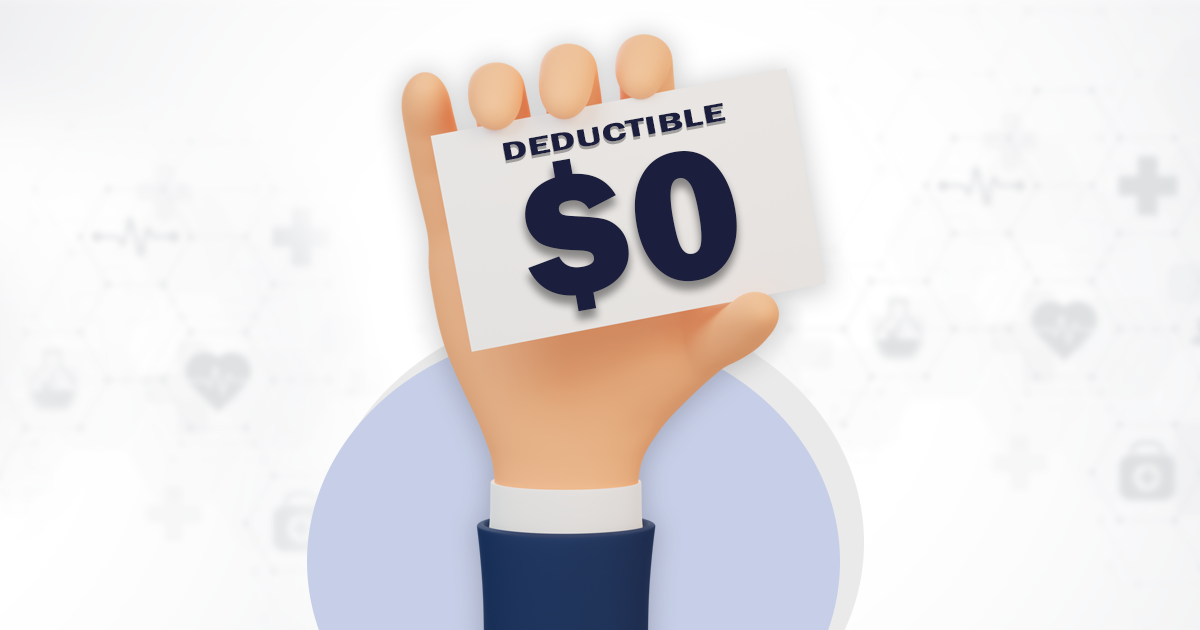Deductibles are one of the most important things inside a health insurance plan. Everyone’s main goal should be to try and get this number as low as possible. You would be surprised to see how many people qualify to get that sweet $0! Learn everything like what it is and how it works, the pros and cons, how to get it, and more. Think of this as the Complete Guide to Zero Deductible Health Insurance. Let’s begin!
Key Takeaways
- A $0 deductible health plan does not mean it is free!
- 90% of Cuspide clients have a $0 deductible plan.
- Every income level qualifies for no deductible health insurance.
What is a 0 deductible health insurance plan?
Before you can understand what a no deductible plan is, you must know what the basics are. A deductible is a fee that you must pay yourself before the insurance company starts to pay. So, a $0 deductible health insurance plan means that you don’t have to pay any fee before you receive medical care.
For example, if you had a $500 deductible and you go see a doctor and the visit cost $100, you will need to pay the full $100 and now you have $400 left. With a no deductible plan, you would not need to pay anything upfront. These types of plans are the most sought-out after in the Obamacare marketplace. And around 90% of our clients at Cuspide have them!

How does zero deductible health insurance work?
Health insurance with $0 deductible works by giving the person immediate coverage since they do not have to pay any fee upfront for medical care. However, this does not mean that the plan is free. You may end up paying a little extra in premiums for the luxury (more on this later). And, aside from deductibles, you still have copays and an out-of-pocket maximum. For example, while your deductible may be $0 you would still need to pay $10 per visit to see your primary doctor.
Who is zero deductible health insurance best for?
While everyone’s goal in health insurance should be to find as low a deductible as possible, there are still certainly those who may benefit from it the most. Should you get it? Is it for you?
PEOPLE EXPECTING FREQUENT MEDICAL CARE should look at low deductible health plans because of their needs. If you or someone in your family has a certain condition that needs to be regularly checked it is recommended to find a $0 deductible health insurance plan because you won’t need to pay any fee upfront. While (sometimes) you may pay slightly more in monthly premiums, your wallet will thank you once you are at the doctor’s office.
FAMILIES WITH DEPENDENTS (children or elderly) are the best candidates for non-deductible plans because kids and seniors are more likely to get sick. Which ties back to the first reasons for expecting a lot of care.
INDIVIDUALS AND FAMILIES WITH LIMITED BUDGETS might be better off with low deductibles because when it comes time to go to the doctor you will end up paying much less. Sometimes, you may end up paying a little more in premiums but that is a great trade. If a plan had a $3,000 deductible and it cost $20 extra a month to bring it to zero, it would be a good decision made by you.
EMPLOYEES under an employer-sponsored plan might get offered a $0 deductible plan and that means that you just struck gold! You should always compare the options and look at the benefits, but that is a steal!

What are the types of deductibles in health insurance?
Aside from your “normal” deductibles (more than $0 and less than $1,600), there are 2 types of deductibles in the Health Insurance Marketplace. They are $0 Deductible and High Deductible Health Plans. Since all the insurance companies offer both types of plans, you have freedom of choice. Both have their strengths and weaknesses and could be a better choice depending on your circumstances. Let’s dive in.
No-Deductible Health Plan
The caviar of a health insurance plan is $0 deductible. It is the most flexible out of the 2 because of the predictable costs and the “financial freedom” it has when it is time to use the plan. Depending on your income, it will usually be more expensive than a regular deductible plan or a HDHP.
Best for: Individuals and families who expect frequent medical care and want predictable costs.
High Deductible Health Plan (HDHP)
A high deductible health plan, otherwise known as a HDHP, is a plan with higher deductibles than a traditional plan but has the lowest premiums. These plans will usually also have high out-of-pocket maximums and copays. Everyone has a different definition for “high” but in the health insurance marketplace, HDHPs are plans with a $7,500 deductible or more. A common version of a HDHP is a plan with the same deductible and OOPM and the copays are “no charge after deductible”. These are essentially “accidental” plans.
High deductibles health plans are best for:
- Young and healthy people who expect little to no medical care.
- Those with a Health Savings Account (HSA). Since HDHPs are compatible with HSAs they allow individuals to save pre-tax dollars for qualified medical expenses.
- Those with financial flexibility can look at HDHPs because they can cover the out-of-pocket costs if an emergency comes up while paying low premiums.
Figure out your needs before you choose which way you want to go. If you are looking at getting a high deductible health plan to save money, just be careful! If there is an emergency and you must utilize the plan, it will be very expensive! Which is why we always recommend $0 deductible even for a “just in case” scenario.
How do you get zero deductible health insurance?
While what you will pay depends on your income, it is important to know that everyone will be able to get health insurance with no deductible. Some will pay more than others of course. If you want that $0 in your plan, below are 3 factors you must consider.
1. Correctly estimate Income
Since Obamacare (ACA) is mainly based on income, your first step should be to try and correctly estimate your income for the year. To put it simply, if you underestimate your income, you will have to pay back the premium tax credit at the end of the year, and if you overestimate it, you will get some money back because you should have received more credit. So, those households who make more will have to pay a little extra for the $0.
2. Compare plans
So many people reading this right now qualify, and they don’t realize! There are hundreds of plans in the health insurance marketplace, so you should always try to compare and look for the best option. While all companies will have non-deductible plans, they will differ in every other way. We suggest looking for a silver plan as they have cost sharing reductions and plans with low copays (make sure they are fixed fees and not percentages).
3. Speak to professional
If this all sounds too complicated and like a lot of work, all the previous reasons stated can be done for you by an insurance agent. The last thing you want to do is to try and do an application yourself (trust us, we have seen the aftermath). We can help with figuring out income, who’s applying, dependents, and comparing plans. Give us a call at (305) 970-8583 and get shown many affordable plans in the marketplace.
Get Health Insurance with No Deductible today!
Here at Cuspide we take pride in getting our clients the most affordable plans. Always. Get services like comparing plans, making payments, finding doctors, and more! (No one else is doing this.) Contact us today at (305) 970-8583 to get covered in under 10 minutes.
Pros and Cons of $0 Deductible Health Insurance
While it is still the best choice, there are still advantages and disadvantages to having a $0 deductible health insurance plan. Let’s talk about them so there aren’t any surprises later.
Benefits of No Deductible Health Insurance
- You have no deductible! With this type of plan, you will have no upfront costs unlike a more traditional plan, so you get coverage right away.
- Lots of the time people neglect medical care because they worry about the costs, so they end up not doing anything about it. With no deductible, you will be more inclined to check up on your health.
- Perfect for those who expect frequent care or have chronic conditions, since you will only have to focus on copays.
- No deductible plans are budget friendly options because they will not break your wallet when it comes time to visit the doctor.
Disadvantages of a 0 Deductible Health Plan
- Higher premiums are the main disadvantage of having a $0 deductible health insurance plan. However, since this is all based on income, it may not even apply to you, and it could still be cheap!
- Out-of-pocket costs could be a little higher than a traditional plan due to the immediate coverage.
As you can see, the pros outweigh the cons and there is almost no reason why you should not have that zero. Our first goal when getting clients enrolled is looking for that $0. The price difference will barely be noticeable (for the most part) and you get a huge advantage over any other type of plan.

How much does zero deductible health insurance cost?
What you will pay for a no deductible plan depends on your household income (the less you make, the less it will cost you.) However, all income levels will qualify. To find out an estimate of how much you will pay, use our premium tax credit calculator tool. Based on the average, a 0 deductible health insurance plan will cost around $7,710 annually. To get an exact amount, contact Cuspide at (305) 970-8583 and get a quote at no cost!
Frequently asked questions
If you have any questions related to health insurance, contact Cuspide via phone, email, or text. We look forward to helping you and getting you the coverage you need!
What companies have 0 deductible health insurance plans?
All the health insurance companies in the ACA marketplace offer $0 deductible plans. (BlueCross & BlueShield, Oscar, Ambetter, Aetna, UnitedHealthcare, to name a few). They do not have the same copays, out-of-pocket max, or premiums, so it is best to compare and find out which one works best for you.
Look at things like what type of plan it is (HMO, EPO, PPO, etc.), are the copays a fixed amount or are they percentages, how much will it cost monthly, and so on. We recommend contacting an insurance agent to help you compare and choose the best option.
Is health insurance with no deductible good or bad?
$0 deductible plans are the best choice you can make when buying health insurance. They are good for people who will go to the doctor a lot and even for those who just want something for emergencies. On top of that, they will also save you the most money in the long run compared to a normal plan. Most of our clients have a $0 deductible because we truly believe that it is the best.
Do I qualify for 0 deductible health insurance?
Yes, individuals and families of any income level will qualify for no deductible health plans. If you meet the regular insurance requirements (like being a citizen or resident of the United States, never been to prison, and meeting the minimum income for Obamacare) you will be eligible. This doesn’t mean that everyone will pay the same of course. Those who make more will have to spend a little more on that luxury. Contact us at (305) 970-8583 and get more information!
Bottom Line
When shopping for a marketplace plan there are many things to look for. However, everyone should aim to get zero deductible health insurance because of the no upfront costs that it provides and the freedom you get knowing that you will not need to pay anything, yet.
Whether you have insurance just for emergencies or need to go get checked frequently, it will always be the best choice. Even if it means paying a little more monthly, when it comes time to go to the doctor, you will be glad you made the decision. As always, contact Cuspide for all your health insurance needs!



